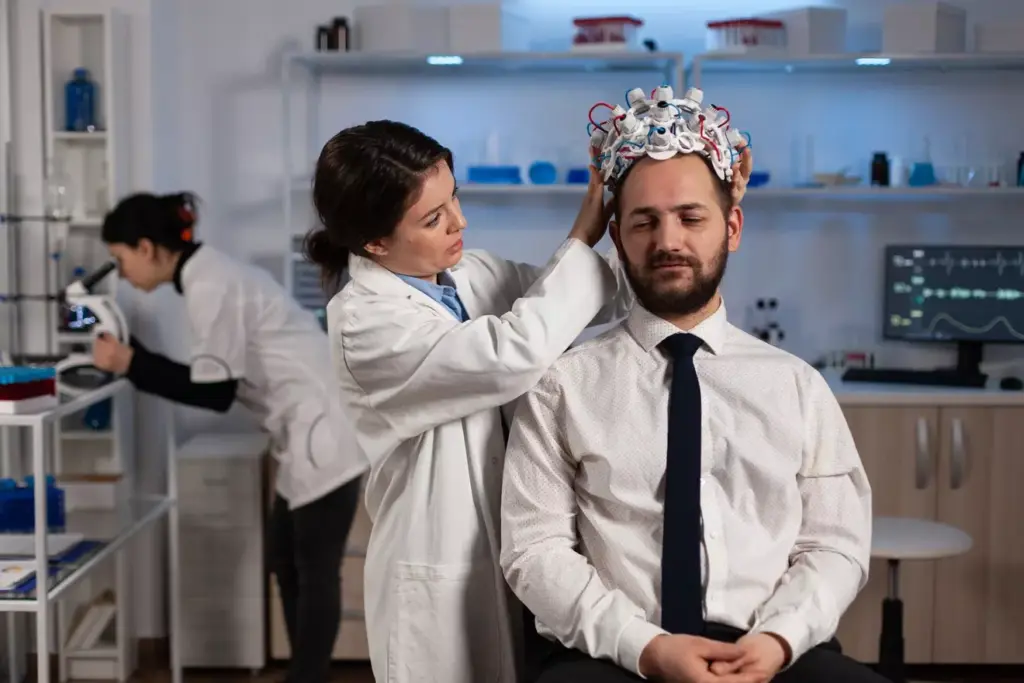Last Updated on November 27, 2025 by Bilal Hasdemir

Cancer of the nervous system, including CNS tumors, refers to abnormal growths in the brain and spinal cord. These conditions are complex and can significantly impact patients’ lives. At Liv Hospital, we understand the importance of accurate diagnosis and compassionate care.
In 2022, there were an estimated 321,476 new cases of brain and CNS tumors. This shows the growing need for awareness and advanced treatment options. Understanding the key facts about these conditions is critical for patients, caregivers, and healthcare professionals. We are committed to delivering world-class healthcare with complete support for international patients.
Key Takeaways
- CNS tumors include a range of diseases affecting the brain and spinal cord.
- The incidence of brain and CNS tumors is rising globally.
- Accurate diagnosis and treatment are critical for patient outcomes.
- Liv Hospital provides patient-centered care for complex conditions.
- Advanced treatment options are available for managing CNS tumors.
What Defines Cancer of the Nervous System
Cancer of the nervous system is a complex condition. It involves abnormal cell growth in the brain and spinal cord. These growths, or tumors, can harm the central nervous system (CNS). They lead to various neurological symptoms and complications.
CNS tumors are rare but serious. They can deeply affect patients and their families. It’s vital to know about their nature and characteristics.
Abnormal Growths in the Brain and Spinal Cord
Abnormal growths in the CNS come from different cell types. These include glial cells, neurons, and meningeal cells. Some growths are benign, while others are malignant and dangerous.
Primary CNS tumors start in the CNS. Secondary CNS tumors come from cancer spreading to the CNS from other areas.
Primary CNS tumors rarely spread outside the nervous system. But, they can grow into other brain parts. This makes treatment hard.
Experts say, “The way CNS tumors spread is a big challenge for treatment.”
Primary vs. Secondary CNS Tumors
It’s important to know the difference between primary and secondary CNS tumors. Primary CNS tumors, like glioblastoma and medulloblastoma, start in the CNS. Secondary CNS tumors come from cancer spreading to the CNS from other places.
The type of tumor affects treatment and outlook. For example, primary CNS tumors might need surgery or radiation. Secondary CNS tumors often need treatments that target both the CNS and the original cancer site.
In summary, cancer of the nervous system is complex. Knowing about primary and secondary CNS tumors helps us diagnose and treat better.
The Global Impact: Incidence and Mortality Statistics
The global burden of CNS tumors is a big concern, with more cases worldwide. It’s important to understand the numbers to fight these diseases better.
Worldwide Burden: 321,476 New Cases in 2022
In 2022, brain and CNS tumors affected many, with 321,476 new cases worldwide. This shows how big a problem CNS tumors are for health globally. They caused 248,305 deaths that year.
This high death rate shows we need better treatments and care for patients.
United States Projections for 2025
By 2025, CNS tumors will keep affecting the U.S. hard. There will be about 24,820 new cases and 18,330 deaths. These numbers show we must keep working on treatments and care.
The numbers show CNS tumors’ big impact worldwide and in the U.S. We need to keep researching and improving health care. This way, we can help more patients with CNS tumors.
Common Types of Primary CNS Tumors
It’s important to know about the different primary CNS tumors. They can be benign or malignant. Each type has its own characteristics and effects on patients.
Brain Tumor Classifications
Brain tumors are sorted by their cell origin. The main types include:
- Glioblastomas: These are aggressive and malignant, coming from brain glial cells.
- Meningiomas: Usually benign, they grow in the meninges, the brain’s protective membranes.
- Pituitary Tumors: These occur in the pituitary gland. They’re often benign and affect hormone levels.
These tumors differ in how aggressive they are and how they affect a patient’s life. Getting the right diagnosis is key to finding the best treatment.
Spinal Cord Tumor Types
Spinal cord tumors are sorted by where they are and what cell they come from. The main types are:
- Schwannomas: Benign tumors from Schwann cells, which cover nerve fibers.
- Meningiomas: Like brain meningiomas, these benign tumors grow in the spinal cord’s meninges.
- Ependymomas: Tumors from ependymal cells lining the spinal cord’s central canal.
These spinal cord tumors can cause symptoms like pain, numbness, and trouble moving. Symptoms depend on the tumor’s size and where it is.
Primary CNS tumors, whether in the brain or spinal cord, are a big challenge. Knowing about these tumors is the first step to creating effective treatment plans.
Regional and Socioeconomic Disparities in CNS Tumors
Looking at CNS tumors globally, we see big differences in who gets them and how they do. These differences are linked to where people live and their economic status. The way these tumors affect people varies greatly around the world.
Higher Incidence in Developed Countries
Research shows that CNS tumors are more common in rich countries than in poorer ones. This gap is due to better healthcare and technology in wealthier areas. Advanced neuroimaging techniques like MRI and CT scans are more common there, helping doctors diagnose faster and more accurately.
Also, older people are more common in rich countries. As people get older, they’re more likely to get certain CNS tumors. This adds to the higher numbers seen in these countries.
Elevated Mortality in Lower-Resource Settings
Even though CNS tumors are more common in rich countries, the death rates are actually higher in poorer areas. This is because of big challenges in treating these tumors in less developed places. These challenges include not having good healthcare, getting diagnosed late, and not having the right treatments.
In poorer areas, there’s a lack of advanced tools and treatments for CNS tumors. These issues stop people from getting the care they need.
It’s important to understand these differences to help more people with CNS tumors. By tackling these disparities, we can improve care for patients everywhere.
Unique Characteristics of Cancer of the Nervous System
It’s key to know how CNS tumors work to find good treatments. Cancer in the nervous system, like in the brain, acts differently than other cancers.
Limited Metastasis Beyond the CNS
CNS tumors don’t usually spread far from the brain or spinal cord. This is unlike many cancers that can go to other parts of the body. This helps doctors focus their treatments better.
But, this also makes things tough. The brain’s tight space means small tumors can cause big problems. They can press on or get into nearby brain areas.
Local Infiltration Patterns
CNS tumors often spread into the brain or spinal cord. This makes it hard to tell where the tumor ends and normal tissue starts. It’s a big challenge for surgery.
How they spread can vary. Some grow as clear masses, while others spread out. This makes them tricky to find and treat.
Knowing these special traits helps doctors create better treatments. These treatments aim to fight CNS tumors without harming the brain or spinal cord too much.
Recognizing Symptoms of CNS Tumors
CNS tumors can have subtle symptoms, but catching them early is vital. Spotting these signs early helps doctors treat them better. This can greatly improve a patient’s life and treatment success.
Brain Tumor Warning Signs
Brain tumors show different symptoms based on where and how big they are. Common signs include:
- Headaches that keep coming back and get worse, often with nausea and vomiting.
- Seizures, which might be new or happen more often if you’ve had them before.
- Cognitive changes, like memory loss, confusion, or trouble focusing.
- Motor symptoms, such as weakness, numbness, or paralysis in different body parts.
A, leading neurosurgeon, says, “Spotting these symptoms early can lead to quicker diagnosis and better treatment.”
Spinal Tumor Manifestations
Spinal tumors, whether they’re benign or cancerous, can cause various symptoms. These symptoms come from the tumor pressing on or growing into the spinal cord or nerve roots. Key symptoms include:
- Back pain that lasts and might spread to other areas, like the arms or legs.
- Neurological deficits, such as weakness, numbness, or tingling in the limbs.
- Coordination and balance problems, as the tumor affects the spinal cord’s signal transmission.
- Bowel and bladder dysfunction, which can happen if the tumor presses on nerves controlling these functions.
It’s critical for patients and doctors to know these symptoms. This helps in early diagnosis and treatment. The American Cancer Society stresses, “Quick medical care can greatly improve treatment results for CNS tumors.”
Diagnostic Approaches for CNS Malignancies
Getting a precise diagnosis for CNS tumors is key for good treatment plans. We use top-notch imaging and detailed histological analysis. This ensures we accurately identify and understand CNS malignancies.
Advanced Neuroimaging Techniques
Neuroimaging is essential for spotting CNS tumors. Magnetic Resonance Imaging (MRI) and Computed Tomography (CT) scans help see where and how big the tumors are. MRI is great for seeing the details of tumors and planning surgeries.
Functional MRI (fMRI) and Diffusion Tensor Imaging (DTI) give more insights into tumor biology. They show how tumors affect the brain around them. These tools help tell tumor types apart and check on brain pathways.
| Neuroimaging Technique | Primary Use in CNS Tumor Diagnosis |
|---|---|
| MRI | High-resolution imaging of tumor anatomy |
| CT Scan | Rapid assessment of tumor size and calcification |
| fMRI | Mapping brain function and tumor impact |
| DTI | Visualizing white matter tracts and tumor infiltration |
Histopathological Confirmation
Neuroimaging gives us a lot of info, but tissue samples are the best way to confirm CNS tumors. We get these samples through biopsies or surgeries. Then, skilled neuropathologists examine them.
Looking at the tissue helps us understand the tumor’s shape, grade, and molecular details. This info is vital for knowing the tumor type, predicting outcomes, and planning treatments.
By combining advanced imaging and tissue analysis, we can give accurate diagnoses. This helps us create personalized treatment plans for CNS malignancies.
Treatment Strategies for CNS Tumors
CNS tumors are a big challenge. They need personalized treatment plans. The right treatment depends on the tumor type, location, and the patient’s health.
Surgical Resection Options
Surgery is often the first step for many CNS tumors. It aims to remove as much of the tumor as possible. This helps keep the brain working right.
Key surgical considerations include:
- Tumor location and accessibility
- Extent of tumor resection required
- Potential for neurological deficit
Radiation-Based Therapies
Radiation therapy is key in treating CNS tumors. It can be used alone or with surgery. Different types of radiation are used to target tumors well without harming the brain too much.
“Radiation therapy has become an indispensable tool in the treatment of CNS tumors, providing precise and effective tumor control.” –
| Radiation Technique | Application | Benefits |
|---|---|---|
| Stereotactic Radiosurgery | Precise delivery of high-dose radiation to small tumors | High precision, minimal side effects |
| Fractionated Radiotherapy | Delivery of radiation in multiple fractions to larger tumors | Effective for larger tumors, reduced long-term toxicity |
Systemic and Targeted Treatments
Systemic therapies like chemotherapy and targeted treatments are used more now. They help when surgery or radiation isn’t possible.
New discoveries in molecular diagnostics help make targeted therapies. For example, CLR 275 is showing promise in early trials for some CNS tumors.
We keep working on new treatments. This gives hope for better outcomes for CNS tumor patients.
Prognosis Factors and Survival Trends
CNS tumor prognosis involves many factors. It’s key to understand these to give patients the right information and help with treatment choices.
Tumor Type and Grade Influence
The prognosis of CNS tumors depends a lot on their type and grade. High-grade tumors usually have a worse outlook than low-grade tumors. For example, glioblastoma, a high-grade glioma, often has a poor prognosis. On the other hand, low-grade astrocytomas might have a better chance of recovery.
“The prognosis for patients with CNS tumors varies a lot,” experts in neuro-oncology say. “It depends on the tumor type, grade, and the patient’s age.”
Age and Functional Status Impact
Age and how well a person functions also play big roles in prognosis. Younger patients who are more active tend to do better. Performance scales, like the Karnofsky Performance Status (KPS), help measure a patient’s health and predict their chances.
Every patient’s case is different, and prognosis can change a lot even with the same tumor type and grade. So, it’s very important to look at all the factors when talking about prognosis with patients and their families.
Survival rates for CNS tumors have been getting better thanks to new treatments and care. But, we need more research to keep improving patient outcomes.
Recent Advances in CNS Tumor Management
Advances in molecular diagnostics and immunotherapy are changing how we treat CNS tumors. These breakthroughs have greatly improved patient results. They are changing how we manage CNS tumors.
Molecular Diagnostics
Molecular diagnostics are key in managing CNS tumors. They help us understand a tumor’s genetic makeup. This lets us choose treatments that fit each patient better.
Genomic sequencing has helped us understand CNS tumors better. We can now find genetic changes that make tumors grow. For example, finding IDH mutations in gliomas has led to new treatments in trials.
Immunotherapy Approaches
Immunotherapy is a new hope for treating CNS tumors. It uses the immune system to target cancer cells. Different methods, like checkpoint inhibitors, cancer vaccines, and CAR T-cell therapy, are being tested.
Checkpoint inhibitors have shown great results in treating some CNS tumors. They help the immune system fight cancer cells better. Researchers are working to find the best ways to use these treatments.
These advances in molecular diagnostics and immunotherapy are making treatments better. They are also helping us learn more about CNS tumors. As research keeps going, we’ll see even more new ways to fight these cancers.
Conclusion: The Future of CNS Tumor Research and Care
As we face the challenges of cancer in the nervous system and CNS tumors, we see a bright future. Ongoing research and care advancements are key to better patient outcomes. New trends in molecular diagnostics and immunotherapy are opening up new treatment paths.
Improving CNS tumor care is a top priority. We aim to give patients the best support and care. Charity events, like those for Mount Vernon Cancer Centre, show the need for more research and care funding.
By deepening our knowledge of CNS cancer, we can create better treatments. This will improve the lives of patients and their families. It’s vital to keep focusing on research and care to beat CNS tumors.
FAQ
What is cancer of the nervous system?
Cancer of the nervous system affects the brain and spinal cord. It causes a lot of suffering and death. These cancers can start in the brain or come from other parts of the body.
What are the main types of CNS tumors?
CNS tumors include brain tumors like gliomas and meningiomas, and spinal cord tumors. These tumors can be harmless or very dangerous. They vary a lot in how they affect people.
What are the symptoms of CNS tumors?
Symptoms include headaches, seizures, and weakness. You might also feel numbness or changes in how you think or feel. Back pain and numbness in the limbs are signs of spinal tumors.
How are CNS tumors diagnosed?
Doctors use MRI and CT scans to find CNS tumors. They then confirm the diagnosis with a biopsy or surgery. Knowing the exact type of tumor is key for treatment.
What are the treatment options for CNS tumors?
Treatments include surgery, radiation, and special medicines. The best option depends on the tumor’s type, size, and where it is. It also depends on the patient’s health.
What is the prognosis for patients with CNS tumors?
The outlook depends on the tumor type, the patient’s age, and how well they can function. Knowing these details helps doctors give accurate information and plan the best treatment.
What are the recent advances in CNS tumor management?
New advances include better tests and treatments like immunotherapy. These changes offer hope for better care and outcomes for CNS tumor patients.
What is the global impact of CNS tumors?
CNS tumors affect people worldwide, with 321,476 new cases in 2022. Rates vary by region and country, influenced by healthcare access and wealth.
How do regional and socioeconomic disparities affect CNS tumor outcomes?
Disparities in healthcare and wealth impact outcomes. Developed countries see more cases, while poorer areas face higher death rates. Understanding these issues helps in finding solutions.
What is the role of molecular diagnostics in CNS tumor management?
Molecular diagnostics are vital for managing CNS tumors. They help diagnose accurately and guide treatment. This approach tailors care to each patient’s needs.
What is an intracranial mass?
An intracranial mass is an abnormal growth in the brain. It can be harmless or dangerous. Symptoms include headaches, seizures, and changes in thinking or mood.
How do CNS tumors affect the brain and spinal cord?
CNS tumors can harm the brain and spinal cord by pressing on or spreading into nearby areas. This can cause many symptoms and serious health issues.
References
- National Cancer Institute (NCI). Adult Brain (Central Nervous System) Tumors Treatment – PDQ®. Retrieved from https://www.cancer.gov/types/brain/hp/adult-brain-treatment-pdq
- Zhang, Q., et al. Global, Regional, and National Burden of Brain and Central Nervous System Cancers: A Systematic Analysis Based on GBD 2021. PubMed. Retrieved from https://pubmed.ncbi.nlm.nih.gov/40171571/ (PubMed)
- Zhao, X., He, M., Yang, R., Zhu, X., Tang, N., Geng, N. The global, regional, and national brain and central nervous system cancer burden and trends from 1990 to 2021: an analysis based on the Global Burden of Disease Study 2021. Frontiers in Neurology. Retrieved from https://www.frontiersin.org/journals/neurology/articles/10.3389/fneur.2025.1574614/full (Frontiers)
- Nature Scientific Reports. [Article Title]. Retrieved from https://www.nature.com/articles/s41598-025-04636-7
- SEER. Cancer Stat Facts: Brain and Other Nervous System Cancer. Retrieved from https://seer.cancer.gov/statfacts/html/brain.html








